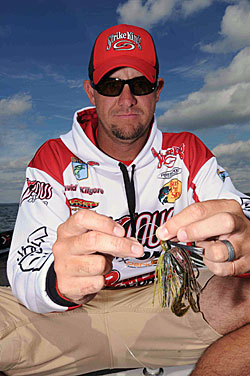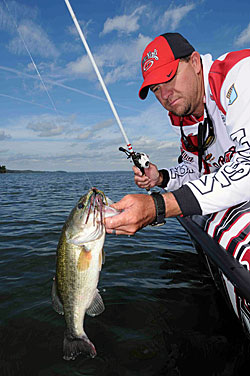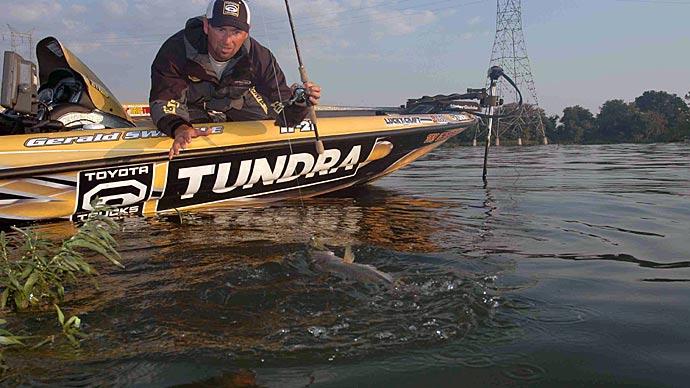
During the March 2014 Bassmaster Southern Open on Alabama’s Smith Lake, David Kilgore led the tournament after scoring heavy limits the first two days, mainly fishing an umbrella rig around docks.
However, on the event's final day, Kilgore had only three keepers at mid-day as bass kept hitting and missing the umbrella rig. So the Jasper, Ala., angler tied on a 3/8-ounce Strike King Hack Attack Jig with a Strike King Rage Tail Chunk for a trailer and started swimming the combo in the shady areas of docks. The move paid off for Kilgore as the short strikes became solid hookups. The swimming jig tactic helped Kilgore complete a 16-pound, 13-ounce limit that clinched the victory for the hometown favorite.
Kilgore’s victory proved a swim jig is an ideal subtle alternative when bass seem reluctant to bite a spinnerbait or other blade baits. “I think a spinnerbait overwhelms shallow fish a lot of times with all that flash and stuff,” Kilgore says. “Of course, every fish on the planet Earth has also seen a spinnerbait. The jig usually comes through (weeds) more naturally than a spinnerbait will.”
The two-time Bassmaster Classic qualifier also believes a swim jig will trigger more strikes than a spinnerbait when it is paused and allowed to sink. “If you pop a jig in the right place and then kill it, the fish are liable to smoke it just out of a reaction bite,” he says.
Spring is Kilgore’s favorite season to swim a jig when the water temperature climbs into the 58- to 70-degree range. His preferred targets for jig swimming are grass, wood, and boat docks.
Kilgore considers stained water and low light with a breeze ideal for swimming a jig. The swim jig also produces Kilgore in clear water early in the morning or on a sunny afternoon as long as there is some wind.
A stout hook and a streamlined head are two key features Kilgore looks for in a good swim jig. He wants his swim jig equipped with a “gaffe hook” that won’t bend on the hook set. The four-time B.A.S.S. winner prefers a jig with a pointed head rather than a round head to knife through weeds more easily. “You want it to deflect off that stuff well and not get hung up where it changes the action of the jig,” he says.

Strike King’s Hack Attack Heavy Cover Swim Jig is Kilgore’s choice for luring big bass out of the weeds. “I have a garage full of them,” Kilgore says. The swim jig is built with a Strike King Gamakatsu extra strong Siwash hook for a solid hookup and a heavy weed guard to slide through thick cover without bogging down in the weeds or tree limbs.
The size of the swim jig Kilgore chooses depends on his fishing depth. “I like to swim a 3/8-ounce jig if I had to pick just one,” Kilgore says. “But sometimes the fish get picky and want it slow in shallow water, so then I swim a 1/4 (ounce). Sometimes I swim a 1/2 ounce if I have to fish it deeper.”
Kilgore has four color options for his swim jigs. He selects a white jig for fishing in stained water early in the morning and picks a black-and-blue model for swimming in clear or stained water. A shad pattern (sexy shad, chartreuse sexy shad, or smokey shad hues) work best for him in clear water whenever shad are abundant, and a bream or bluegill hue produces best when the sunfish are spawning.
Strike King Rage Tail Baby Craws, or Rage Tail Chunks are Kilgore’s favorite jig trailers for swim jigs most of the time. He favors a 4-inch Rage Tail Craw when he needs to swim his jig in deeper weeds. His color selections for the jig-and-trailer combo are the following: white jig with pearl trailer; bream jig/green pumpkin trailer; black-and-blue jig/black, blue, or black-blue flake trailer; shad jig/pearl or blue glimmer trailer.
When swimming his jig in the grass, Kilgore presents his lure in the middle of the vegetation and then works it to the edges. “I like to get it up in the grass, but if the fish are getting it right on the edge of the grass, I will start swimming it down the edge,” he says. “You just have to let the fish tell you where to swim it.”
Kilgore experiments with retrieves until he finds out how the fish want his swim jig presented. “I will just throw it and wind it sometimes,” he says. “Then I will just pop it sometimes.” The tournament veteran works his swim jig with a 7-foot heavy action Duckett Micro Magic Pro rod and Duckett 360 baitcast reel (7.1:1 gear ratio) spooled with 50-pound Vicious Fishing Braid in moss green.
Whether swimming the jig around grass or docks, Kilgore also varies the depth of his retrieve by keeping the lure in sight or just out of sight. “I am sort of a visual freak,” he says. “I like to watch it all happen.” But he knows there are times when he has to swim the jig deeper and out of visual range to trigger strikes.
Kilgore says that the swim jig triggers strikes from both small and big fish. “You catch numbers swimming a jig, but it will catch a big one,” he says. “It is not something that will take you out of the game by just fishing for a monster.”
BassResource may receive a portion of revenues if you make a purchase using a link above.




